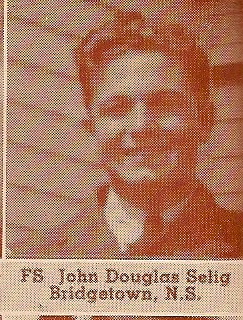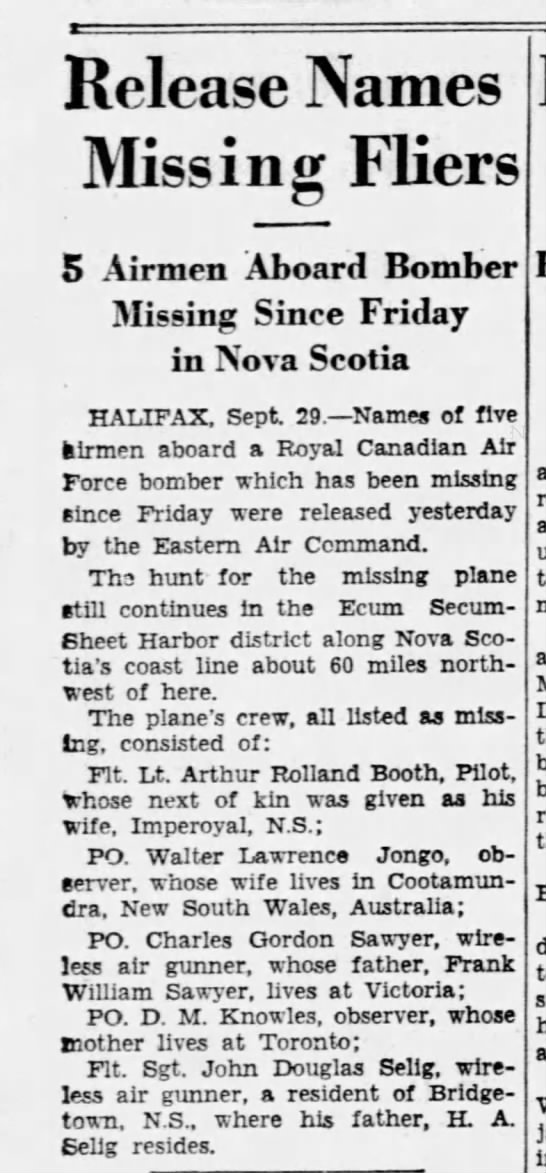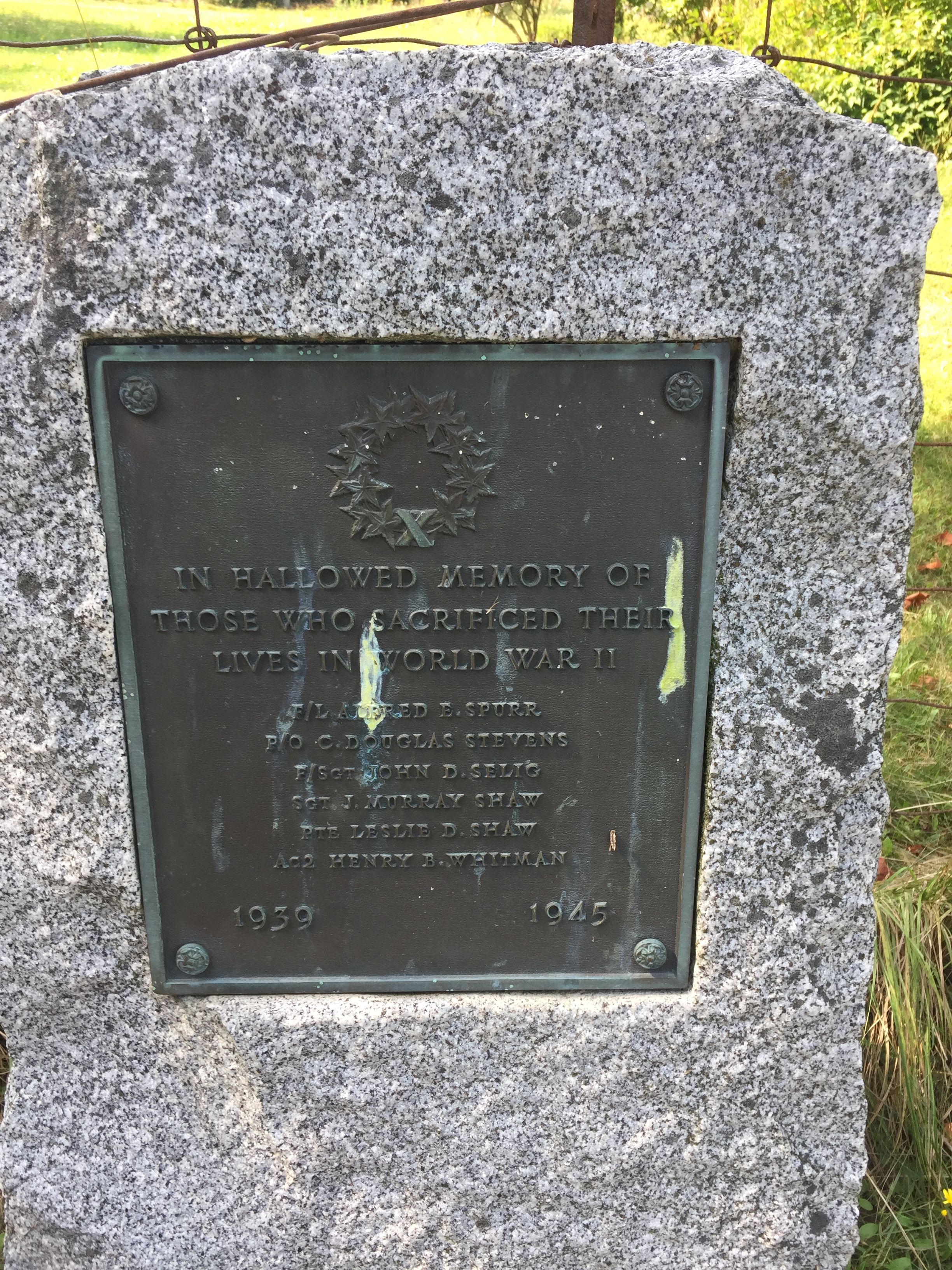






August 18, 1922 - September 25, 1942







John Douglas Selig, born in Lawrencetown, Nova Scotia, was the son of Harry Anderson Selig, railway employee, and Cora Violet Selig, of Bridgetown, Nova Scotia. He had one younger brother, Russel Alvin Selig. The family was Baptist.
John was a student living in Round Hill, NS, prior to his enlistment with the RCAF in October 1940. He had $11.29 in his Royal Bank of Canada bank account in Lawrencetown, NS as well as 4 certificates of $100 War Savings Certificates, plus 2 $100 Victory Loan Bonds. He also had a life insurance policy.
He was mechanically inclined. He occasionally participated in hockey, baseball, running and jumping. He stood 5’ 7 ½” tall, weighed 147 pounds, had blue eyes and brown hair. “Has Grade X. Had to work hard outside school. Sturdy built. Suitable for Wireless Air Gunner.”
John started his journey through the BCATP at No. 2 Manning Depot, Brandon, Manitoba. He was at No. 1 Wireless School, Montreal, from December 9, 1940 until April 27, 1941. He was 92nd out of 119 in his class and passed with 63.4%. “Has not exhibited any qualities, while at this school, to recommend him for a commission. He is rather young to make any definite recommendations at the moment, but will probably develop into an excellent NCO with further experience.” John forfeited one day’s pay as he was AWL from December 21-22, 1940.
At No. 4 BGS, Fingal, from May 26 to June 23, 1941: “22nd out of 57 in class. Held over for a second course. Rather slow but works hard.” He earned his Air Gunner’s badge on June 23, 1941.
He was taken on strength with No. 11 BR Squadron, Dartmouth, Nova Scotia July 9, 1941. John was at the station hospital from July 22 - 24, 141 and again October 1 - 3, 1941. He was at Rockcliffe in May 1942, then Moncton, then to No. 9 B&G School, Mont Joli in June 1942, was at Sydney, a week later, then back to Dartmouth by September 15, 1942.
According to an article in the Ottawa Journal dated September 29, 1942, “The hunt for the missing plane still continues along Nova Scotia coastline about 60 miles northwest of Halifax. The plane’s crew, all listed as missing, consisted of F/L Arthur Rolland Booth, pilot, whose next of kin was given as his wife, Imperoyal, NS. P/O Walter Lawrence Junge, observer, whose wife lives in Cootamundra, NSW, Australia. P/O Charles Gordon Sawyer, WAG, whose father, Frank William Sawyer, lives at Victoria; P/O David McGillvray Knowles, observer, whose mother lives at Toronto; F/Sgt John Douglas Selig, WAG, a resident of Bridgetown NS, where his father, H.A. Selig, resides.”
In the Court of Inquiry, found in reel C-5936, image 1075, Arthur Booth had experience flying Fleet, Harvard, Fairey Battle, Anson and Hudson aircraft. He was a fully qualified captain of Hudson aircraft. The observer, F/O Junge was a good observer who had flown on many patrols. Twelve witnesses were called.
DESCRIPTION OF FLIGHT: “F/L Booth, pilot and crew of 4 took off at 0340 hours ADT in Hudson Mark III 454 detailed to carry out an outer A/S patrol. The ETA of the aircraft at the base was 1300 hours ADT. At 1334 hours ADT when the aircraft had not arrived at base, a message was passed to Command for transmission requesting the pilot to send his ETA. This message was transmitted at 1405 hours ADT but Hudson 454 did not reply to this message. At 1500 hours ADT, it was assumed that the aircraft could be out of gas and search proceedings were instituted and continued until the 6th of October. Forty-nine flights were made in an exhaustive search for the missing Hudson and personnel but not trace of the missing aircraft or personnel has been found. There was evidence that a Hudson aircraft was over the convoy during the morning of September 25, 1942 and was last seen at 1200 hours ADT. This aircraft is considered to have been Hudson 454.
The first witness, S/L Albin Laut, C861, assistant controller, Dartmouth, indicated that the captain of the convoy escort reported a Hudson aircraft intermittently throughout the morning. It was last seen at 1200 ADT. This must have been Hudson 454 as the relief aircraft did not take off base until 1230 ADT.
The fourth witness, LAC Arnold Avery Malone, R104172, indicated he assisted with the refuelling of the aircraft before It was put up for the night. “I was on the wings and saw that the gas tanks were full.”
The sixth witness, LAC Zado Zator, R85069, airframe mechanic said that he checked the guages in the aircraft and “with a flashlight, I checked the tanks with the help of another man on the wing.”
The eighth witness, LAC Perry Ralph Cole, R119683, AEM, said that he spoke with F/L Booth. “I was standing near Hudson 454 when F/L Booth came out to the aircraft at 0520 hours. I followed him into the cockpit of the aircraft. I saw him start up the engines and then he signed the L.1 and the crew list which I now submit as evidence. He asked me if the aircraft was ready to go. He said the aircraft was serviceable last night and should be already to go now. I saw five people in the aircraft. I did not know all of them by sight, but there were four officers in the aircraft and one flight sergeant as Wireless Operator. I knew F/L Booth and his Australian Observer, P/O Junge.”
The tenth witness, S/L William Charles VanCamp, C873, Officer Commanding detailed F/L Booth and his crew to carry out an outer A/S patrol. “F/L Booth was a fully qualified captain of Hudson aircraft both by day and night. P/O Junge was a good observer who had flown on many patrols with 11 (BR). P/O Knowles, another observer, was under instruction having recently joined the Squadron. Both P/O Sawyer and F/S Selig were experienced wireless operators who had flown on patrols with the Squadron.”
INVESTIGATION: Cause: Unknown. RECOMMENDATION: The court being unable to ascertain details of this accident is unable to make any recommendations.
FINDINGS: That Hudson 454 took off from RCAF Station, Dartmouth, NS on an outer anti-submarine patrol for a convoy at 0540 hours ADT on the 25th September 1942 and did not return, is missing and it is reasonable to suppose that it is lost.
CONCLUSION: Hudson, with an experienced pilot and crew, failed to return from an anti-submarine patrol. Considered lost at sea. Cause unknown.
A memo from the RCMP dated November 23, 1942: “It will be observed that inquiries have continued by our Sherbrooke and Sheet Harbour Detachments in an effort to secure information concerning the location of the forced landing of this aircraft, but without success, and in view of the length of time which has now elapsed since this airplane was first reported as missing, I am now considering my file as closed as there appears that little further can be done.”
In late October 1955, Mrs. Selig received a letter informing her that since John had no known grave, his name would appear on the Ottawa Memorial.
John Douglas Selig is remembered in the Round Hill Cemetery, Annapolis County, Nova Scotia along with five other men. “In hallowed memory of those who sacrificed their lives in World War II, 1939-1935.”